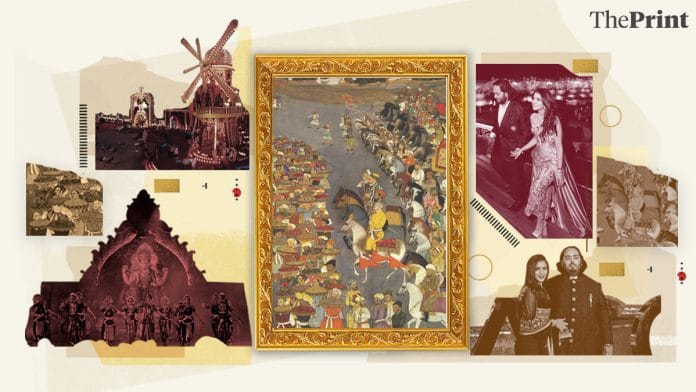Asia’s richest man is hosting a wedding, and the world must watch. As a fresh wave of PR and publicity hits the news cycle, what’s striking about the Ambani festivities is what they signify. The wedding is a symbol: it uses a language of power and display. Indian royals, Asia’s richest men in bygone centuries, would have understood it very well.
The political ritual of the royal wedding
For thousands of years, the marriage of two elite families has served to unite their interests. They might marry to end hostilities or to unite against a common enemy. Or they might simply aim to bind themselves closer together. Medieval South India has plenty of examples. One of the most dramatic comes from the Deccan Plateau in the 9th century CE.
At the time, India’s dominant rulers were the Rashtrakutas, a dynasty based in north Karnataka. They had a long-standing rivalry with the Ganga family, around present-day Bengaluru. Around 850 CE, the Rashtrakuta emperor Amoghavarsha—praised by the Arabs as one of the world’s ‘four great kings’—ordered his generals to crush the Gangas. He commanded: “Extirpate the Ganga country, that lofty forest of fig-trees, difficult to cut down.” The campaign was derailed for various reasons. About a decade later, Amoghavarsha had two of his daughters marry Ganga princes, and the two families became close allies until their extinction over a century later.
Medieval marriages marked a prince’s emergence onto the public stage. In the Yashastilaka, an epic Jain romance by a Rashtrakuta poet, the royal hero is married immediately after his coronation, and he parades to his palace on an elephant, accompanied by his new queen. Further south, Chola royals travelled to give strategic gifts to temples. In their donative inscriptions, they usually mentioned their spouses’ names. In return for their status as the super-rich of the times, they needed to be publicly pious and visibly fulfil societal expectations.
Perhaps the Ambani-Merchant wedding is not a geopolitical or commercial alliance. But, like medieval marriages, the couple carefully conforms to society’s expectations, and it’s helping launch Anant Ambani into the public consciousness. We are told, for example, the couple’s love story, since “love-cum-arranged marriages” strike the perfect balance between tradition and modernity. Anant Ambani shares his health struggles on stage (accompanied by close-ups of his parents’ reactions). We are told of his private sanctuary, which allegedly rescues animals. Radhika Merchant serves food to the public. Just like medieval weddings, there’s a lot that the Ambani wedding is presenting to its audience: conspicuous charity; temple piety; love, and health awareness.
Also Read: What do a Hindu king and a Muslim sultan have in common? Both looted Kashmir’s temples
Overwhelming wealth
The societal expectation is fulfilled, so now the elite wedding is free to indulge itself with blinding glamour. The numbers reported for the Ambani wedding are staggering, to the point where it’s difficult to find a medieval comparison—let alone a medieval equivalent. Medieval marriages were glamorous, involving the attendance of hundreds of lords and ladies, housed in temporary cities of wood and cloth. Dozens of priests were hired, and fabulous gifts of gold, cloth, and imported animals were presented. We don’t have very reliable numbers from before 1200, but early modern India has better-documented weddings.
Take, for example, the marriage of the Mughal prince Dara Shikoh in 1633. According to his biographer, Supriya Gandhi, the total cost of the nuptials—including pearls, jewels, golden elephant howdahs, umbrellas, charity, utensils, tents, and textiles—was Rs 32 lakh. This works out to more than $48 million today. Reportedly, just the first of two Ambani pre-wedding bashes cost $151 million. Including the ongoing bash off the coast of Italy, and the actual wedding itself, the total cost might easily double or triple. Whatever one thinks of India’s economic situation, it’s sobering that India’s richest man has already spent—quite easily—thrice the amount of a Mughal prince’s wedding.
But why are the Ambanis spending this much? I am sure we’ll find out sooner or later. In the meantime, we can ask why premodern weddings were made into such spectacular occasions. For Dara Shikoh, according to Gandhi, the expenditure was a sign of Shah Jahan’s fabulous wealth and generosity. One million lamps; fireworks in the shape of elephants, giants, and turrets, extending for half a mile. Guests “received sashes woven of gold thread, and the harem servants laid out for them… a spread of flowers, betel-leaf stimulants, perfumes, and an array of appetisers and fruits.”
Such public affections, according to Mughal historian Munis Faruqui, were intended to bolster Dara’s position as Shah Jahan’s favoured heir: his seniormost, most dignified son. Will Anant Ambani have a bigger role to play in the Ambani Group’s public profile in the future? Medieval Indian kings would say yes, absolutely.
The author would like to thank Ashwitha Jayakumar for her advice on sources.
Anirudh Kanisetti is a public historian. He is the author of Lords of the Deccan, a new history of medieval South India, and hosts the Echoes of India and Yuddha podcasts. He tweets @AKanisetti. Views are personal.
This article is a part of the ‘Thinking Medieval‘ series that takes a deep dive into India’s medieval culture, politics, and history.
(Edited by Zoya Bhatti)






